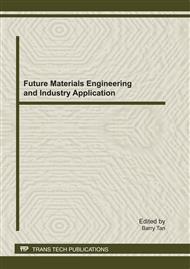[1]
Das M, Banerjee R, Bal S (2008). Evaluation of physicochemical properties of enzyme treated brown rice (Part B). LWT -Food Sci. Technol. 41, 2092-(2096).
DOI: 10.1016/j.lwt.2007.11.018
Google Scholar
[2]
Fukushima K, Sogo K, Miura S, Kimura Y (2004). Production of D-lactic acid by bacterial fermentation of rice starch. Macromol. Biosci. 4, 1021-1027.
DOI: 10.1002/mabi.200400080
Google Scholar
[3]
He JY, Deng JJ, Zheng YH, Gu J (2006). A synergistic effect on the production of S-adenosyl-l-methionine in Pichia pastoris by knocking in of S-adenosyl-l-methionine synthase and knocking out of cystathionine-synthase. J. Biotechnol. 126, 519-527.
DOI: 10.1016/j.jbiotec.2006.05.009
Google Scholar
[4]
Heerink N, Qu FT, Kuiper M, Shi XP, Tan SH (2007). Policy reforms, rice production and sustainable land use in China: a macro-micro analysis. Agr. Syst. 94, 784-800.
DOI: 10.1016/j.agsy.2006.11.005
Google Scholar
[5]
John RP, Sukumaran RK, Nampoothiri KM, Pandey A (2007).
Google Scholar
[6]
Lee CW (2007). Production of D-lactic acid by bacterial fermentation of rice. Fiber Polym. 8: 571-578.
Google Scholar
[7]
Liang JF, Han BZ, Nout MJR, Hamer RJ (2008). Effects of soaking, germination and fermentation on phytic acid, total and in vitro soluble zinc in brown rice. Food Chem. 110, 821-828.
DOI: 10.1016/j.foodchem.2008.02.064
Google Scholar
[8]
Lin JP, Tian J, You JF, Jin ZH, Xu ZN, Cen PL (2004). An effective strategy for the co-production of S-adenosyl-l-methionine and glutathione by fed-batch fermentation. Biochem. Engin. J. 21, 19–25.
DOI: 10.1016/j.bej.2004.04.013
Google Scholar
[9]
Liu H, Lin JP, Wu JP, Cen PL (2002). Production of S-adenosyl-lmethionine using Saccharomyces cerevisiae by bioconversion of L-methionine. Chem. React. Eng. Tech. (In Chinese) 18 (4), 310-314.
Google Scholar
[10]
Lu ZD, Lu MB, He F, Yu LJ (2009). An economical approach for D-lactics acid production utilizing unpolished rice from aging paddy as major nutrient source. Bioresou. Technol. 100, 2026-(2031).
DOI: 10.1016/j.biortech.2008.10.015
Google Scholar
[11]
Miller GL (1959). Use of dinitro salicylic acid reagent for determination of reducing sugar. Ann. Chem. 31, 426-428.
Google Scholar
[12]
Mincheva KP, Balutsov VM (2002). Isolation of a Kluyveromyces lactis Mutant Enriched in S-Adenosyl-L-Methionine and Growing in Whey Medium. Appl. Biochem. Microbiol. 38(4), 335-338.
Google Scholar
[13]
Shimizu S, Yamada H (1984). Microbial and enzymatic processes for the production of pharmacologically important nucleosides. Trends Biotechnol. 2, 137-141.
DOI: 10.1016/0167-7799(84)90023-4
Google Scholar
[14]
Shiomi N, Fukuda H, Fukuda Y, Murata K, Kimura A (1990). Production of S-adenosylmethionine by Saccharomyces cerevisiae cells carying a gene for ethionine resistance. Biotechnol. Bioeng. 35, 1120–1124.
DOI: 10.1002/bit.260351107
Google Scholar
[15]
Wang WJ, Xiao J (2007). Study on Screening S-adenosyl-L-methionine -hyperproducing mutant and Cultivation Conditions by Saccharomyces cerevisiae. J. Wuhan Polytechnic University (In Chinese) 26(4), 17-21.
Google Scholar
[16]
Zhang JG, Wang XG, Zhang JN, Wei DZ (2008). Oxygen vectors used for S-adenosylmethionine production in recombinant Pichia pastoris with sorbitolas supplemental carbon source. J. Biosci. Bioeng. 105(4), 335-340.
DOI: 10.1263/jbb.105.335
Google Scholar


